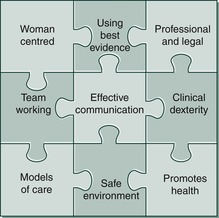Chapter 1. Introduction
This book is the second in the Midwifery Essentials series aimed at student midwives and those who support them in clinical practice. It focuses on antenatal care for low-risk women beginning with how antenatal care is organized and then taking the reader through the pregnancy journey. Scenarios are used throughout the book to facilitate learning and assist the reader to apply this knowledge to their own practice areas. In particular, one woman, Joanna, is followed throughout the course of her pregnancy, to illustrate how different issues become more pertinent or prominent at different times along the way. The mantra for contemporary maternity care is choice, access and continuity of care within a safe and effective service (Department of Health 2004; Department of Health 2007). The focus of this book is to explore ways in which this aspiration can become a reality for women and their families.
The aim of this introductory chapter is:
▪ To introduce the ‘jigsaw model’ for exploring effective midwifery practice.
The jigsaw model (Fig. 1.1) is used throughout the book, except for Chapter 2, which provides a general introduction to the various models of antenatal care currently available.
 |
| Fig. 1.1 Jigsaw model: dimensions of effective midwifery care |
Midwifery care model
One of the purposes of this series is to consider the care of women and their babies from an holistic viewpoint. This means considering the care from a physical, emotional, psychological, spiritual, social and cultural context. To do this we have devised a jigsaw model of care that will encourage the reader to consider individual aspects of care, while recognizing that these aspects go to make up part of the whole person being cared for.
This model will be used to reflect on the clinical scenarios described in the chapters. It shows the dimensions for effective maternity care and each should be considered during the assessment, planning, implementation and evaluation of an aspect of care.
The pieces of the jigsaw (Fig. 1.1) clearly interlink with each other and each is needed for the provision of safe, holistic care. When one is missing the picture will be incomplete and care will not reach its potential. Each aspect of the model is described below in more detail. It is recommended that when an aspect of midwifery care is being evaluated each piece of the jigsaw is addressed. Consider the questions pertaining to each piece of the jigsaw and work through those that are relevant to the clinical situation you face.
Woman-centred care
The provision of woman-centred care was one of the central messages of the policy document Changing Childbirth (Department of Health 1993) which turned the focus of maternity care from meeting the needs of the professionals to listening and responding to the aspirations of women. This is further enforced in the National service framework (Department of Health 2004) and Maternity matters (Department of Health 2007) and is an expectation of midwifery practice (NMC 2004) and pre-registration education (NMC 2004). When considering particular aspects of care the questions that need to be addressed to ensure that the woman’s care is woman-centred include:
▪ Was the woman involved in the development of her care plan and its subsequent implementation?
▪ Should her family or carers also be involved?
▪ How can I ensure that she remains involved in further decisions about her care?
▪ What are the implications of undertaking or not undertaking this procedure on this particular woman or baby?
▪ Are there any factors that I need to consider that might influence the results of this procedure for this woman and their impact on her?
▪ How does this procedure fit in with the woman’s hopes, expectations and meanings?
▪ Is now the most appropriate time to undertake this procedure?
Using best evidence
The NMC Code states ‘you must deliver care based on the best available evidence or best practice’ (NMC 2008:04). Midwifery evidence includes many aspects (Wickham 2004) and the decisions a midwife makes about her practice will be influenced by a range of factors. However, in the statement above, care should be based as much as possible on the ‘best’ evidence, and reflect national guidance (NICE 2008) as appropriate.
Questions that need to be addressed when exploring the evidence base of care include:
▪ What is already known about this aspect of care?
▪ What is the justification for the choices made about care?
▪ What is the research evidence available on this procedure/test?
▪ Do local guidelines reflect best evidence?
▪ Was a midwife involved in development of local/national guidelines?
▪ Who represents users of maternity services on groups where guidelines are developed?
▪ What midwifery research project has your Trust been involved in?
▪ Where do you go first in order to identify sources of best evidence?
Professional and legal
Midwives who practise in the United Kingdom must adhere to the rules and guidance of the Nursing and Midwifery Council (NMC). The Code states:
As a professional you are accountable for actions and omissions in your practice and must always justify your decisions. You must always act lawfully, whether those laws relate to your professional practice or personal life.
(NMC 2008:01)
Midwives are therefore required to comply with English law and the rules and regulations of their employers.
Stay updated, free articles. Join our Telegram channel

Full access? Get Clinical Tree


